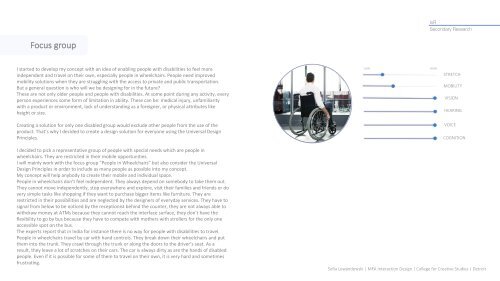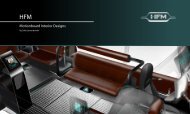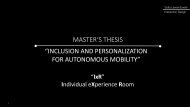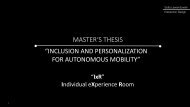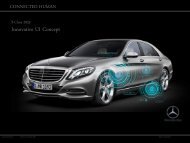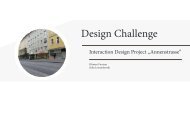Documentation_IxR_Lewandowski
Create successful ePaper yourself
Turn your PDF publications into a flip-book with our unique Google optimized e-Paper software.
<strong>IxR</strong><br />
Secondary Research<br />
Focus group<br />
I started to develop my concept with an idea of enabling people with disabilities to feel more<br />
independent and travel on their own, especially people in wheelchairs. People need improved<br />
mobility solutions when they are struggling with the access to private and public transportation.<br />
But a general question is who will we be designing for in the future?<br />
These are not only older people and people with disabilities. At some point during any activity, every<br />
person experiences some form of limitation in ability. These can be: medical injury, unfamiliarity<br />
with a product or environment, lack of understanding as a foreigner, or physical attributes like<br />
height or size.<br />
LOW<br />
HIGH<br />
STRETCH<br />
MOBILITY<br />
VISION<br />
HEARING<br />
Creating a solution for only one disabled group would exclude other people from the use of the<br />
product. That’s why I decided to create a design solution for everyone using the Universal Design<br />
Principles.<br />
VOICE<br />
COGNITION<br />
I decided to pick a representative group of people with special needs which are people in<br />
wheelchairs. They are restricted in their mobile opportunities.<br />
I will mainly work with the focus group “People in Wheelchairs” but also consider the Universal<br />
Design Principles in order to include as many people as possible into my concept.<br />
My concept will help anybody to create their mobile and individual space.<br />
People in wheelchairs don’t feel independent. They always depend on somebody to take them out.<br />
They cannot move independently, stop everywhere and explore, visit their families and friends or do<br />
very simple tasks like shopping if they want to purchase bigger items like furniture. They are<br />
restricted in their possibilities and are neglected by the designers of everyday services. They have to<br />
signal from below to be noticed by the receptionist behind the counter, they are not always able to<br />
withdraw money at ATMs because they cannot reach the interface surface, they don’t have the<br />
flexibility to go by bus because they have to compete with mothers with strollers for the only one<br />
accessible spot on the bus.<br />
The experts report that in India for instance there is no way for people with disabilities to travel.<br />
People in wheelchairs travel by car with hand controls. They break down their wheelchairs and put<br />
them into the trunk. They crawl through the trunk or along the doors to the driver’s seat. As a<br />
result, they leave a lot of scratches on their cars. The car is always dirty as are the hands of disabled<br />
people. Even if it is possible for some of them to travel on their own, it is very hard and sometimes<br />
frustrating.<br />
Sofia <strong>Lewandowski</strong> | MFA Interaction Design | College for Creative Studies | Detroit


